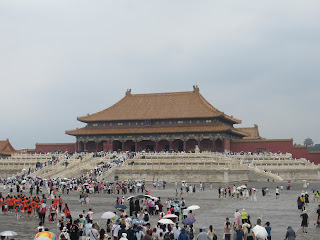Kunming
We left Chengdu on a fast train headed for Kunming.The first part of the journeywas through unchanging countryside but th last section was through mountains. Unfortunately, th etrack has been straightened and it runs through long series of tunnels. All we saw were glimpses of deep valleys cutting through muntains as the track left the portal of one tunnel to cross a valley and dive into another tunnel.
Kunming was a pleasue after the stifling heat and humidity of Beijing just a couple of days before. Kunming its at an elevation of 1,900 metres so is cooler. Chinese tourists come here for the weather as it is mild, annual average temperature is 14C. It is known for its flowers and exports flowers across China and the neighbouring countries.
During the Second World War, Kunming was a Chinese military centre and the location of Headquarters American Army Forces, China, Burma, and India (HQ AAF CBI). The airbase served as the home of the First American Volunteer Group of th Republic of China Air Force, nicknamed the Flying Tigers and was the transport terminus for the Burma Road.
Although Japan was focusing on ending the war in China at the Battles of Chongqing and Chengdu, Junming was not out of the reach of Japanese air raids, and faced attacks by Japanese bombers. The city of Kunming was prepared as an alternate National Redoubt in case the temporary capital in Chongqing fell, with an elaborate system of caves to serve as offices, barracks and factories, but never utilised. Kunming was to have served again in this role during the ensuing civil war, but the Nationalist garrison there switched sides and joined the Communists. Instead, Taiwan become the last redoubt and home of the Republic of China government, a role it fulfills to this day.
But there were no military assets promoted to the tourist. I anted to see the Stone Forest, an area of karst formations some 90 kilometres out of the city but there was insufficient time to travel there by bus to see it. Instead, I went to visit the Yunnan Nationalities Village. It shows details of the traditional way of lfe of 26 of the minor ethnic communities in the province. It is part ethnographic museum and part theme park.
The former entrance to the site...
...now replaced with an arch and shopping arcade full of restaurants, cafes and souvenir shops before you even get to the ticket office.
A pagoa, and like most of the buildings in the park, they are built to look old and none are original.
A lamaestery in the Tibetan village.
A peacock in the peacock garden.
A stupa.
I can't remember the ethnic group but these figures adorn the entrance to the souvenir shop cum cafe in their village.
Inside one of the Mongolian houses.
And so each ethnic group have a village featuring their way of life, culture and archetecture.
One of the games set up in a village to throw balls through a hoop.
A pretty bridge across one of the many lakes around the site.
More buildings.
Surprise.




















































